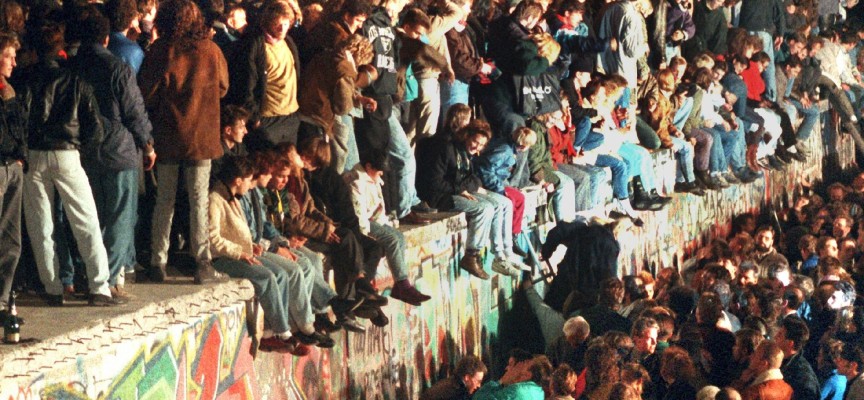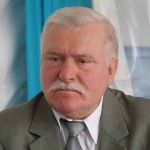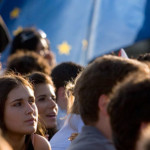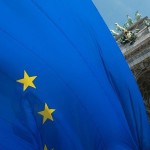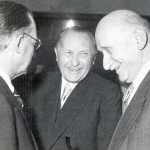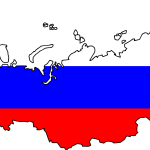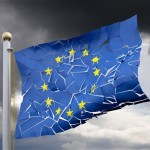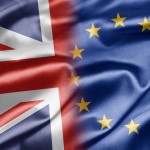To understand the reasons for the construction of the wall separating in two parts the ancient capital city of the Reich, we must go back to the beginning of 1945. The war is not over yet, but Nazi Germany is on the verge of capitulation. February 4 through 11, 1945, the Yalta Conference is held. For a whole week, at the edge of the Black Sea, Churchill, Stalin, and Roosevelt confer on the future of Germany and Japan whose defeat is no longer in doubt.
What future for Germany?
When the conference begins, Stalin’s Red Army had already reached East Germany. Allied troops, however, have not yet crossed the Rhine. Hence the confidence shown by Stalin to his Western allies. Such confidence is even increased by the fact that Roosevelt is ill (he will die three months later) and Churchill is physically worn.
The three Allied leaders plan to demilitarize Germany and cut it into three occupation zones, which eventually become four; Churchill, in fact, soon obtained an area to be given to France.
In this discussion on sharing out, there is of course no question of challenging the territories that the USSR has already annexed or is about to annex. Thus it retains the Baltic States, Moldova, Karelia, Eastern Poland, and Eastern Prussia.
At the capitulation of the Reich, Germany finds itself split into two parts: the Federal Republic of Germany on the west side and the German Democratic Republic, on the east side, under the control of the USSR. Berlin, the capital city of the Reich, is divided into four zones.
Europe split into two parts
On the night of August 12 to 13, 1961, in an attempt to stop the growing exodus of people to West Germany and to other democratic countries of Europe, the pro-Soviet authorities of the German Democratic Republic erected a 150 km wall – which will be called very soon the “Berlin Wall” – and physically separated the city into East Berlin and West Berlin. In one night, German families find themselves separated. They will remain separated for 28 years!
This wall, a component of the inner-German border for more than twenty-eight years, is the most prominent symbol of Europe divided by the Iron Curtain. More than just a wall, it is a complex military system which includes two walls, each of them 3.6 meters high, walkways, 302 observation towers endowed with alarm devices, 14,000 guards, 600 dogs, and skyward barbed wire. An unknown number of people died while trying to cross the wall, because East German border guards and Soviet soldiers did not hesitate to shoot the fugitives.
A wind of freedom and renewal
But what happened on November 9, 1989? To understand this event which in our collective memory truly symbolizes the fall of communism in Eastern Europe, we must remember, first, the advent of Mikhail Gorbachev in 1985, who initiated reforms of the communist political and economic system, in the Soviet Union, which will return to be called Russia a few years later. We should also remember the creation of the free trade union “Solidarnosc” (Solidarity) in Poland, which opposed a peaceful but firm resistance to the communist regime in this country. It should also be recalled that in spring 1989, the wave of protest led to the opening of the “iron curtain” in Hungary, which will provide an opportunity for thousands of East Germans to flee abroad. A wind of freedom and renewal had begun to blow on the “Eastern bloc”, and nothing could stop it.
In the following months, street rallies are regularly organized, and they get increasingly important. The apex will be a giant rally on November 4, 1989, which brought more than a million people to East Berlin, in addition to hundreds of thousands protesters in other cities of East Germany. A few days later, on November 9, a senior official of the German communist regime announced during a press conference that private trips abroad are now allowed without conditions. Following this announcement, and under the pressure of thousands of East Berliners, many crossing points were opened in the “wall”, thus allowing a crowd of excited and incredulous people to embrace their separated siblings in West Berlin. The wall had fallen … Less than a year later, on October 3, 1990, the two halves of Germany were reunited.
The role of Christians
This page of history is well known, especially by those who, at the time, followed these events through radio and television throughout Europe. What is less known is that the Protestant Churches in East Germany played an important role in the fall of the Berlin Wall – in a way that recalls the resistance of Catholics in Soviet Poland. While some Lutheran bishops “collaborated” with the East German communist regime, many Christian faithful actively resisted it for decades. This movement eventually lead to the “Monday rallies” first inside and then around the “Nikolaikirche” (Church of St. Nicolas) in Leipzig. On October 9, 70,000 people gathered to pray and then march through the city in the light of candles. Neither the army nor the police stepped in: the totalitarian regime was undermined without blood being shed. These were the first street rallies, supported by an active movement for democratization, which would lead to the large rallies of November 1989.
Pour comprendre les raisons de la construction de ce mur séparant en deux l’ancienne capitale du Reich, il faut remonter au début de l’année 1945. La guerre n’est pas encore finie, mais l’Allemagne nazie est sur le point de capituler. Du 4 au 11 février 1945 se tient la conférence de Yalta. Pendant une semaine, au bord de la mer Noire, Churchill, Staline et Roosevelt se concertent sur le sort futur de l’Allemagne et du Japon dont la défaite ne fait plus de doute.
Quel avenir pour l’Allemagne?
Quand commence la conférence, l’Armée rouge de Staline a déjà atteint l’Allemagne orientale. Les troupes alliées, en revanche, n’ont pas encore franchi le Rhin. D’où l’assurance dont fait preuve Staline face à ses alliés occidentaux. Assurance d’autant plus grande que Roosevelt est malade (il mourra trois mois plus tard) et Churchill physiquement usé.
Les trois chefs alliés projettent de démilitariser l’Allemagne et de la découper en trois zones d’occupation, qui deviendront finalement quatre zones; Churchill ayant obtenu après coup qu’une zone soit accordée à la France.
Dans cette discussion sur le partage, il n’est bien entendu pas question de contester à l’URSS les territoires qu’elle a déjà annexés ou s’apprête à le faire. C’est ainsi qu’elle conserve les États baltes, la Moldavie, la Carélie, la Pologne orientale et même la Prusse orientale.
A la capitulation du Reich, l’Allemagne se retrouve donc coupée en deux: la République fédérale d’Allemagne du côté occidental et la République Démocratique d’Allemagne (RDA), du côté oriental, et sous contrôle de l’URSS. Berlin, la capitale du Reich est séparée en quatre zones.
L’Europe coupée en deux
Dans la nuit du 12 au 13 août 1961, les autorités pro-soviétiques de la République démocratique allemande (RDA), qui tentent de mettre fin à l’exode croissant de ses habitants vers l’Allemagne de l’Ouest et vers d’autres pays de l’Europe démocratique, érigent un mur long de 150 kilomètres – que l’on appellera très vite le “mur de Berlin” -, séparant physiquement la ville en Berlin-Est et Berlin-Ouest. En une nuit, des familles se trouvent séparées. Elles le resteront pendant 28 ans!
Ce mur, composante de la frontière intérieure allemande, pendant plus de vingt-huit ans, constitue le symbole le plus marquant d’une Europe divisée par le Rideau de fer. Plus qu’un simple mur, il s’agit d’un dispositif militaire complexe comportant deux murs de 3,6 mètres de haut, avec chemin de ronde, 302 miradors et dispositifs d’alarme, 14.000 gardes, 600 chiens et des barbelés dressés vers le ciel. Un nombre indéterminé de personnes sont victimes des tentatives de franchissement du mur, car les gardes-frontière est-allemands et les soldats soviétiques n’hésitent pas à tirer sur les fugitifs.
Un vent de liberté et de renouveau
Mais que s’est-il passé ce 9 novembre 1989? Pour comprendre cet événement qui, dans notre mémoire collective, symbolise véritablement la chute du communisme en Europe de l’Est, il faut rappeler, d’abord, l’avènement de Mikhaïl Gorbatchev en URSS en 1985, qui initia des réformes du système politique et économique communiste, dans ce qui redeviendra la Russie quelques années plus tard. Il faut rappeler aussi la naissance du syndicat libre “Solidarnosc” en Pologne, qui opposa une résistance pacifique mais ferme au pouvoir communiste dans ce pays. Il faut rappeler enfin que, dès le printemps 1989, cette vague de contestation aboutit à l’ouverture du “rideau de fer” en Hongrie, ce qui fournira la possibilité à des milliers d’Allemands de l’Est de fuir vers l’extérieur. Un vent de liberté et de renouveau avait commencé à souffler sur le “bloc de l’Est”, et plus rien ne pourrait l’arrêter.
Dans les mois qui suivirent, des manifestations régulières, et de plus en plus importantes, commencèrent à s’organiser. Elles aboutiront à une démonstration monstre le 4 novembre 1989, rassemblant plus d’un million de personnes à Berlin-Est, et des centaines de milliers d’autres dans plusieurs villes d’Allemagne de l’Est. Quelques jours plus tard, le 9 novembre, un haut responsable du régime communiste annonça, lors d’une conférence de presse inédite, que les voyages privés vers l’étranger seraient désormais autorisés sans conditions. A la suite de cette annonce, et sous la pression de milliers de Berlinois de l’Est, plusieurs points de passage furent ouverts dans le “mur”, permettant à une foule de personnes, à la fois enthousiastes et incrédules, d’aller embrasser leurs frères et sœurs séparés de Berlin-Ouest. Le mur était tombé… Moins d’un an plus tard, le 3 octobre 1990, les deux Allemagnes étaient à nouveau réunies.
Le rôle des chrétiens
Cette page de l’Histoire est connue, surtout par ceux qui, à l’époque, ont suivi ces événements à travers la radio et la télévision, à travers toute l’Europe. Ce qui l’est moins, c’est que les Eglises protestantes d’Allemagne de l’Est jouèrent un rôle important dans la chute du mur de Berlin – d’une manière qui rappelle la résistance des catholiques dans la Pologne soviétique. Si certains évêques luthériens “collaborèrent” avec le régime communiste est-allemand, de nombreux chrétiens de la base lui résistèrent activement pendant plusieurs décennies. Ce mouvement aboutit, en 1989, aux “manifestations du lundi”, dans, puis autour de la “Nikolaikirche” de Leipzig. Le 9 octobre, 70.000 personnes se rassemblent pour prier puis défiler dans la ville à la lumière des bougies. Ni l’armée ni la police n’interviendront: le régime totalitaire sera ébranlé sans que le sang ne soit versé. Ce sont ces premières manifestations, sous-tendues par un mouvement actif de démocratisation, qui aboutiront aux grandes démonstrations du mois de novembre 1989.
Muro di Berlino: il coraggio dei cristiani dell’Est
Berlino celebra il 25° anniversario della caduta del “muro della vergogna”, il 9 novembre 1989. Riflessione su un evento altamente simbolico che ha segnato la fine della “guerra fredda” e la divisione dell’Europa in due blocchi, uno comunista e l’altro democratico.
Per capire le ragioni della costruzione di questo muro che separava in due l’allora capitale del Reich, bisogna risalire all’inizio dell’anno 1945. La guerra non è ancora finita, ma la Germania nazista è sul punto di capitolare. Dal 4 all’11 febbraio 1945 si tiene la conferenza di Yalta. Per una settimana, sulle coste del Mar Nero, Churchill, Stalin e Roosevelt si accordano sulla sorte futura della Germania e del Giappone, la cui disfatta è sicura.
Quale avvenire per la Germania?
Quando comincia la conferenza, l’Armata rossa di Stalin ha già raggiunto la Germania orientale. Le truppe alleate, invece, non hanno ancora superato il Reno. Da qui la sicurezza di cui fa prova Stalin di fronte ai suoi alleati occidentali. Sicurezza tanto più grande dato che Roosevelt è malato (morirà tre mesi più tardi) e Churchill fisicamente consumato.
I tre capi alleati progettano di demilitarizzare la Germania e di suddividerla in tre zone di occupazione, che alla fine diventeranno quattro; Churchill infatti ottenne in seguito che una zona fosse accordata alla Francia.
In questa discussione sulla divisione, ovviamente, non vengono negati all’URSS i territori che ha già annesso o che sta per annettere. È così che mantiene gli stati baltici, la Moldavia, la Carelia, la Polonia orientale come anche la Prussia orientale
Alla caduta del Reich, la Germania si ritrova dunque tagliata in due: la Repubblica federale tedesca nella parte occidentale e la Repubblica democratica tedesca (Ddr), dalla parte orientale e sotto il controllo dell’URSS. Berlino, la capitale del Reich, è divisa in quattro zone.
L’Europa divisa in due
Nella notte tra il 12 e il 13 agosto 1961, le autorità pro-sovietiche della Repubblica democratica tedesca, che tentano di mettere fine all’esodo crescente dei suoi abitanti verso la Germania dell’Ovest e verso altri paesi dell’Europa democratica, erigono un muro lungo 150 chilometri – presto chiamato il “muro di Berlino” – che separa fisicamente la città di Berlino Est e Berlino Ovest. In una sola notte, intere famiglie si ritrovarono separate. E lo resteranno per 28 anni.
Questo muro, rappresentante la frontiera interna tedesca, per più di ventotto anni costituisce il simbolo più incisivo di un’Europa divisa dalla cortina di ferro. Più che un semplice muro, si tratta di un dispositivo militare complesso costituito da due muri di 3,6 metri d’altezza, con un cammino di ronda, 302 torrette e dispositivi d’allarme, 14.000 guardie, 600 cani e filo spinato rivolto al cielo. Un numero indefinito di persone è vittima dei tentativi di attraversamento del muro, poiché i guardia-frontiera della Germania dell’Est e i soldati sovietici non esitano a sparare sui fuggitivi.
Un vento di libertà e di rinnovamento
Ma cosa succede il 9 novembre 1989? Per capire questo evento che, nella nostra memoria collettiva, simboleggia la vera caduta del comunismo in Europa e nell’Est, bisogna ricordarsi, prima di tutto, l’avvento di Mikhaïl Gorbatchov in URSS nel 1985, il quale darà il via alle riforme del sistema politico ed economico comunista, in quella che diventerà la Russia qualche anno più tardi. Bisogna ricordarsi inoltre la nascita del sindacato libero “Solidarnosc” in Polonia, che opporrà una resistenza pacifica ma ferma al potere comunista nel Paese. Bisogna infine ricordarsi che, dalla primavera del 1989, questa onda di contestazione porterà all’apertura della “cortina di ferro” in Ungheria, il che darà la possibilità a migliaia di tedeschi dell’Est di fuggire verso l’esterno. Un vento di libertà e di rinnovamento aveva cominciato a soffiare sul “blocco dell’Est”, e niente poteva più fermarlo.
Nei mesi che seguirono, manifestazioni regolari e sempre più importanti cominciano a organizzarsi. Esse sfociano in una manifestazione il 4 novembre 1989, che riunisce oltre un milione di persone a Berlino Est, e centinaia di migliaia in molte altre città tedesche dell’Est. Qualche giorno dopo, il 9 novembre, un alto responsabile del regime comunista annuncia, nel corso di una conferenza stampa inedita, che i viaggi privati verso l’estero sarebbero stati da quel momento autorizzati senza condizioni. A seguito di questo annuncio, e sotto la pressione di migliaia di berlinesi dell’Est, molti punti di passaggio furono aperti nel “muro”, permettendo a una folla di persone, al tempo entusiaste e incredule, di andare ad abbracciare i loro fratelli e sorelle separati di Berlino Ovest. Il muro era caduto… meno di un anno più tardi, il 3 ottobre 1990, le due Germanie erano di nuovo unite.
Il ruolo dei cristiani
Questa pagina di storia è nota, soprattutto da quelli che, all’epoca, hanno seguito questi avvenimenti attraverso la radio e la televisione in tutta Europa. Ciò che è meno conosciuto è che le Chiese protestanti della Germania Est giocarono un ruolo importante nella caduta del muro di Berlino – in un modo che ricorda la resistenza dei cattolici nella Polonia sovietica. Se alcuni vescovi luterani “collaborarono” con il regime comunista tedesco dell’Est, molti cristiani fin dall’inizio gli resistettero attivamente per diversi decenni. Questo movimento porta, nel 1989, alle “manifestazioni del lunedì”, dentro e poi attorno la “Nikolaikirche” di Lipsia. Il 9 ottobre, 70.000 persone si riuniscono per pregare e poi sfilare nella città alla luce delle candele. Né l’esercito né la polizia intervengono: il regime totalitario sarà scosso senza spargimento di sangue. Sono queste prime manifestazioni, sostenute da un movimento attivo di democratizzazione, che porteranno alle grandi manifestazioni del mese di novembre 1989.
Jean-Jacques Durré
Direttore Media cattolici francofoni (Belgio); Coordinatore delle radio RCF
Latest posts by Jean-Jacques Durré (see all)
- The ideas are there - 2 gennaio 2015
- The Berlin wall: the courage of Eastern christians - 9 novembre 2014
- What choices for the European Union? - 18 giugno 2014

